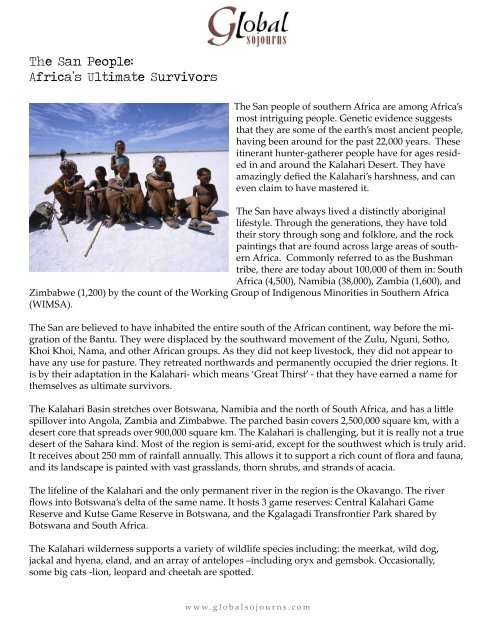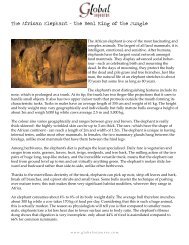The San People: Africa's Ultimate Survivors - Global Sojourns
The San People: Africa's Ultimate Survivors - Global Sojourns
The San People: Africa's Ultimate Survivors - Global Sojourns
Create successful ePaper yourself
Turn your PDF publications into a flip-book with our unique Google optimized e-Paper software.
<strong>The</strong> <strong>San</strong> <strong>People</strong>:<br />
Africa’s <strong>Ultimate</strong> <strong>Survivors</strong><br />
<strong>The</strong> <strong>San</strong> people of southern Africa are among Africa’s<br />
most intriguing people. Genetic evidence suggests<br />
that they are some of the earth’s most ancient people,<br />
having been around for the past 22,000 years. <strong>The</strong>se<br />
itinerant hunter-gatherer people have for ages resided<br />
in and around the Kalahari Desert. <strong>The</strong>y have<br />
amazingly defied the Kalahari’s harshness, and can<br />
even claim to have mastered it.<br />
<strong>The</strong> <strong>San</strong> have always lived a distinctly aboriginal<br />
lifestyle. Through the generations, they have told<br />
their story through song and folklore, and the rock<br />
paintings that are found across large areas of southern<br />
Africa. Commonly referred to as the Bushman<br />
tribe, there are today about 100,000 of them in: South<br />
Africa (4,500), Namibia (38,000), Zambia (1,600), and<br />
Zimbabwe (1,200) by the count of the Working Group of Indigenous Minorities in Southern Africa<br />
(WIMSA).<br />
<strong>The</strong> <strong>San</strong> are believed to have inhabited the entire south of the African continent, way before the migration<br />
of the Bantu. <strong>The</strong>y were displaced by the southward movement of the Zulu, Nguni, Sotho,<br />
Khoi Khoi, Nama, and other African groups. As they did not keep livestock, they did not appear to<br />
have any use for pasture. <strong>The</strong>y retreated northwards and permanently occupied the drier regions. It<br />
is by their adaptation in the Kalahari- which means ‘Great Thirst’ - that they have earned a name for<br />
themselves as ultimate survivors.<br />
<strong>The</strong> Kalahari Basin stretches over Botswana, Namibia and the north of South Africa, and has a little<br />
spillover into Angola, Zambia and Zimbabwe. <strong>The</strong> parched basin covers 2,500,000 square km, with a<br />
desert core that spreads over 900,000 square km. <strong>The</strong> Kalahari is challenging, but it is really not a true<br />
desert of the Sahara kind. Most of the region is semi-arid, except for the southwest which is truly arid.<br />
It receives about 250 mm of rainfall annually. This allows it to support a rich count of flora and fauna,<br />
and its landscape is painted with vast grasslands, thorn shrubs, and strands of acacia.<br />
<strong>The</strong> lifeline of the Kalahari and the only permanent river in the region is the Okavango. <strong>The</strong> river<br />
flows into Botswana’s delta of the same name. It hosts 3 game reserves: Central Kalahari Game<br />
Reserve and Kutse Game Reserve in Botswana, and the Kgalagadi Transfrontier Park shared by<br />
Botswana and South Africa.<br />
<strong>The</strong> Kalahari wilderness supports a variety of wildlife species including: the meerkat, wild dog,<br />
jackal and hyena, eland, and an array of antelopes –including oryx and gemsbok. Occasionally,<br />
some big cats -lion, leopard and cheetah are spotted.<br />
w w w. g l o b a l s o j o u r n s . c o m
<strong>The</strong> <strong>San</strong> are a light skinned folk, whose distinct yellow-brown skin wrinkles prematurely. <strong>The</strong>y havea<br />
body structure slightly smaller than that of the average person. <strong>The</strong>y appear to have bulging foreheads,<br />
ears without lobes, and have taut tufts of flimsy hair. <strong>The</strong> women tend to have ponderous<br />
posteriors- an excellent way for storing fat for lean seasons.<br />
<strong>The</strong>y wear hide slings to cover their essentials. On the move they always carry their animal skin<br />
blankets, and a small hide bag, and a cloak called ‘kaross’. <strong>The</strong> kaross is a multipurpose carrier<br />
pouch in which they carry their very modest material belongings, veld goodies, babies and tools.<br />
<strong>The</strong>y speak in Khoisan, a language characterized by numerous clicks and many idiosyncratic sounds.<br />
<strong>The</strong>ir phonetics are complex, such that in writing, symbols rather than letters are frequently employed.<br />
Various click sounds are expressed differently, for example, the slash (/) for the dental click,<br />
the Alveolar (!) for the palatal click, and double slash (//) for the lateral click. <strong>The</strong>y have influenced the<br />
languages of many southern African tribes who have interacted with them.<br />
<strong>The</strong> <strong>San</strong> have been under great pressure to abandon their itinerant lifestyle, and from the 1950’s<br />
most have become farmers. For example, today in Botswana- the country with the largest <strong>San</strong><br />
population, out of a population of 50,000, only about 3,000 follow the ancient way of life.<br />
<strong>The</strong> traditional <strong>San</strong> live in small groups called bands. Each band comprises of 15 to 25 related<br />
individuals who form a close-knit clan unit. As nomads, they have no need for permanent shelters.<br />
At times they live in rough and ready accommodation - such as caves or erect tent-like structures.<br />
<strong>The</strong>se makeshift structures are made with frames of sticks and thatched with grass and twigs.<br />
In unfavourable weather, animal hide is used in place of grass. <strong>The</strong> band clusters their shelters together<br />
to form a ring, with each family living in a single tent. Each tent has its own campfire, but<br />
there is a central fireplace where the clan gathers to bond and unwind as nightly stories are told. <strong>The</strong><br />
fires are kept alive at all times. Here, stories of hunting experiences, gathering jaunts, daily goings-on,<br />
ancient legends, past music and dance, and religious beliefs are exchanged and passed on.<br />
Though a new birth is important, death is even more significant. <strong>The</strong> spot where a <strong>San</strong> dies is avoided,<br />
and camp must be shifted after the event. <strong>The</strong> family immediately buries its dead, and never<br />
intentionally goes back or crosses the place of burial. If accident or necessity forces them back, they<br />
throw small stones at the grave, and mumble under their breath as they seek peace with the spirit of<br />
the departed.<br />
<strong>The</strong> <strong>San</strong> have no centralised political system or social hierarchy, and decisions touching on community<br />
affairs are arrived at through consensus of both male and female adults, and at times even children<br />
are consulted. When consensus fails, the opinion of the older members of the band is granted more<br />
weight. But when a tie is apparent among the elders or among age-mates, the name rule is invoked.<br />
<strong>The</strong> controversy is resolved in favor of the individual named after a more elderly member of the clan.<br />
<strong>The</strong> <strong>San</strong> practice a division of labour based on gender: the men hunt, while the women gather. <strong>The</strong><br />
children usually just trail along, helping where they can as they assimilate the experience of adults.<br />
<strong>The</strong> older members of the band mostly remain at camp, and watch over the children when their parents<br />
are out hunting and gathering.<br />
This is an opportunity for the elders to pass on their extensive knowledge of their world to the children<br />
in the form of stories and song. <strong>The</strong> <strong>San</strong> are excellent mimics, and it is fun all round as they<br />
mimic various animals, while asking the children to name the animal in play. <strong>The</strong> elderly are the pil-<br />
w w w. g l o b a l s o j o u r n s . c o m
lars of <strong>San</strong> spiritual life. This isan important role as the <strong>San</strong> are quite a spiritual people, believing in<br />
the supernatural world and the existence of a supreme God. This belief permeates everyday life, and<br />
nearly every aspect of their simple lives has a spiritual dimension. For example, they believe that to<br />
hunt is to dance in the spirit.<br />
<strong>The</strong> principle manifestation of their spiritual life is a ritual known as the trance dance. In the setting<br />
for a trance dance, the women and children sit around the fire, while singing and clapping in rhythm.<br />
<strong>The</strong> men encircle the fire in front of the singers and chant frantically, while thumping the ground with<br />
their feet. <strong>The</strong> resident shaman- a spiritual healer- runs around the fire in circles, as he communicates<br />
with the spirit world.<br />
When the dance mood strikes right, the shaman enters into a trance. In this state he is said to have<br />
entered the spirit world, where he is able to consult with the spirits of long departed ancestors and<br />
those causing illness and pain. If the consultation goes well the sick are cured, and if not they depart<br />
unto death. <strong>The</strong> dance is usually performed at the time of the full moon. <strong>The</strong> shaman is always an<br />
elderly man, who in addition to the usual leather sling, is adorned in a beaded headband to which an<br />
ostrich feather is attached. <strong>The</strong>shaman’s gift is deployed in healing, hunting, rain making, and negating<br />
ill-winds in society.<br />
Animals and their interaction with man -especially in the hunt, have a significant role in <strong>San</strong> society.<br />
<strong>The</strong> men hunt with simple but very effective weapons –bows and arrows. <strong>The</strong>ir hunting and tracking<br />
skills are second to none. <strong>The</strong>y tip their arrows with poison obtained from beetles, snakes, scorpions,<br />
tree gum and many others from their catalogue of poisonous animals and plants.<br />
<strong>The</strong> arrows are carried in quivers, and are made in such a way that the shaft dislodges from the head<br />
0n impact. This is to prevent the animal from extricating the poisonous arrowhead and running off.<br />
<strong>The</strong> <strong>San</strong> have a keen and highly trained eye for the hunt. Fresh animal droppings are an easy giveaway.<br />
But most of the time, it is not so easy. By analysinganimal tracks, they are able to guess how far<br />
an animal is gone. This involves observing grass blades, trampled termite nests and other clues in the<br />
path taken by an animal.<br />
<strong>The</strong>se observations can yield surprisingly precise details: species, age, sex, and size of an animal.<br />
For example an examination of the texture of animal droppings hints at the roughage content, and<br />
thus an estimate of an animal’s age: high fibre points a tired digestive system of an older animal.<br />
In a hunt, utmost silence is essential for some animals have very sensitive hearing. Hunters<br />
communicate only through hand signals and signs. <strong>The</strong> hunt is a team work experience, and is a test<br />
of character and discipline. Tracking can sometimes go for more than a day, calling for patience and<br />
endurance. Once the prey falls within shooting range, the most advantageously placed hunter releases<br />
his arrow. <strong>The</strong>re is no rush to immediately subdue the animal, for the poison must be given time to<br />
take its toll.<br />
If the prey runs off or goes into hiding, the <strong>San</strong> call on their intimate knowledge of animal behaviour.<br />
<strong>The</strong>y stand at the point where the animal was shot, mimic its movements until they are able to retrace<br />
its tracks. This they believe is done from a spiritual dimension.<br />
Knowledge of animal behaviour is an integral part of <strong>San</strong> socialization. Reading the mood of an<br />
animal determines the hunt technique to be deployed. For example the hunters may decide that no<br />
subterfuge is required and simply chase an animal to exhaustion. This practice is well captured in a<br />
w w w. g l o b a l s o j o u r n s . c o m
ecent documentary film, ‘<strong>The</strong> Great Dance, a Hunter’s Story’. This film about <strong>San</strong> hunting and tracking<br />
was made by James Hersov, Craig and Damon Foster, and Ellen Windemuth.<br />
To the <strong>San</strong>, hunting is an imperative social and spiritual undertaking. It is a cooperative not a competitive<br />
affair, where all work together to bring down the prey and share in the reward equally. <strong>The</strong><br />
person whose arrow brought down the animal has however first priority to pick his portion of choice.<br />
With the <strong>San</strong> certain animals score higher on the spiritual scale. <strong>The</strong> eland in particular enjoys high<br />
esteem and has a sacred place in the heart of the <strong>San</strong>. It is only hunted when necessary or for special<br />
occasions, for the <strong>San</strong> believes the eland is first among animals, and is his nearest kin in the animal<br />
world.<br />
Folklore instructs them that animals were once humans who after a disagreement turned into elands.<br />
All the other animals were subsequently born of the eland. Every time an eland is hunted, is a time of<br />
great celebration, divination and dancing. <strong>The</strong>se animals are a great subject in most <strong>San</strong> rock paintings.<br />
<strong>The</strong> primary daily task of <strong>San</strong> women is to gather food from the open country, and to take care of<br />
the young and the elderly. All the women of a band go out gathering together, each taking her baby<br />
kaross, a digging stick and small leather bags. <strong>The</strong>y gather berries and other fruits, tubers, bulbs,<br />
nuts, tortoises, lizards, snakes, insects, eggs and small mammals. <strong>The</strong>se foods make a healthy low fat<br />
and low calorie diet which keeps the <strong>San</strong> very lean.<br />
<strong>The</strong> women are very knowledgeable about the wild things of the veld. <strong>The</strong>y seek out many indicators<br />
and can tell what to find where.<br />
As the Kalahari has no surface water, the <strong>San</strong> have had to figure out how to do with little or no water.<br />
<strong>San</strong> women have a way of prospecting for water from the ground using reeds. But this is usually not<br />
necessary as their main source of drinking water is the tsamma melon. This blessed fruit is a wild<br />
desert melon, whose leaves are usable as vegetables, and its seeds are a source of protein and oil.<br />
<strong>The</strong> <strong>San</strong>’s stomach is very strong and versatile. <strong>The</strong>y eat tortoise, lizards, insects, nuts -either raw or<br />
roasted, tubers, bulbs, and many little animals and birds. <strong>The</strong> <strong>San</strong> waste little - ostrich egg shells are<br />
used for water storage, and tortoise shells serve as cutlery.<br />
<strong>San</strong> children are socialised together regardless of gender. But as the children grow older, the boys<br />
are required to tag along with their fathers on hunting trips. This marks the onset of their initiation<br />
process. As they gain in knowledge, they are allowed to shoot a few arrows. When judged to be ready<br />
they are taken on their first eland hunt, and actually allowed to lead. If the hunt is successful, a boy is<br />
automatically initiated into manhood. This is marked by a celebration following the hunt, after which<br />
the boy is at liberty to marry and start a family.<br />
Unlike many African communities, the <strong>San</strong> do not practice circumcision.<br />
For girls, initiation into womanhood is entrusted to nature. Girls are taken as children until their first<br />
experience of menstruation. Because of the <strong>San</strong>’s low fat and calorie diet, this is unlikely to happen<br />
until about the age of 19 years. After this event, the women hold a party in the girl’s honour. <strong>The</strong>y<br />
perform the ‘eland bull dance’ in which they imitate the animal’s mating dance. At this point, she is<br />
considered a woman, ready to be married off to a fine young hunter.<br />
It is acceptable for the parents to find a suitor for their daughter. But girls are not pressured to accept,<br />
w w w. g l o b a l s o j o u r n s . c o m
and are still free to come up with their own choice. Like the rest of their lives, the <strong>San</strong> wedding ceremony<br />
is a simple affair. On a set day, the women apply a mixture of eland fat and red ochre on the<br />
bride. <strong>The</strong>y sing and make merry as they wait for the groom to return from his hunt. On return, the<br />
groom presents his hunt to the bride’s parents, and takes his bride away.<br />
<strong>The</strong> newly weds build their tent-house and start their little hearth. <strong>The</strong>y are free to choose whether to<br />
live with the bride’s or groom’s kin. <strong>The</strong>re is no immediate pressure to start a family; the women chew<br />
on a special tree bark which has contraceptive properties. If a marriage fails to work, the wife simply<br />
returns to her parents’ fireplace, without any life sapping drama.<br />
<strong>The</strong> <strong>San</strong> thrive on an economy of gift exchange. <strong>The</strong>y have little understanding of the concept of private<br />
ownership, as their demands on the world are so few. Since they are nomads, and are constantly<br />
on the move, movable wealth is an unwelcome burden. <strong>The</strong>re is little cause for trade as they share<br />
nearly everything they need, while the rest can almost certainly be picked from the<br />
bush with only a little exertion.<br />
Animal skins serve as clothing, while a nice robe can be made from fibrous and climber plants. Tools<br />
are made from stones, bones, sticks and occasionally, iron.<br />
<strong>The</strong> <strong>San</strong> and their peculiar way of life have always confounded many. You can tell this from the<br />
names others have bestowed on them. Some communities in Zimbabwe call them ‘Batwa’, a Bantu<br />
word meaning ‘people of the unknown’. In Zambia they are referred to as Amasili; Kwankhala in<br />
Angola; Basarwa in Botswana, and <strong>San</strong> in Namibia and South Africa.<br />
<strong>San</strong> is a Khoikhoi and Nama word meaning ‘outsider’. <strong>The</strong> Dutch called them ‘Boschjesmanne’<br />
meaning ‘people of the boschveld’, from which the name Bushman is derived. But the different Kalahari<br />
<strong>San</strong> communities call themselves by different names: for example, a Kalahari group living on the<br />
border of Botswana and Namibia call themselves the Ju/’hoansi, or “the real people.” <strong>The</strong> bushman<br />
term is however today considered to be derogatory, and in South Africa they are officially referred to<br />
as the <strong>San</strong>.<br />
<strong>The</strong> <strong>San</strong> people - and their culture and click consonant language- first came to the attention of the<br />
western world in the 1950s through Laurens van der Post’s book ‘<strong>The</strong> Lost World of the Kalahari’.<br />
This outstanding work was later turned into a BBC TV series.<br />
Many more people came to know of the <strong>San</strong> through the hilarious and unforgettable 1980’s movie<br />
“<strong>The</strong> Gods Must be Crazy”. In this movie, a <strong>San</strong> band encounters the marvels of the outside world in<br />
the form of a coke bottle which falls from a light aircraft. <strong>The</strong>y initially take the bottle to be a gift from<br />
heaven, but in the end come to see it as a curse. <strong>The</strong> documentary, ‘Bushman’s Secrets’ by<br />
Rehad Desai also gives an excellent introduction to the world of the <strong>San</strong>.<br />
<strong>The</strong> arrival of the Dutch and other colonials in the 17th century in <strong>San</strong> territory marked the beginning<br />
of a very difficult period for the <strong>San</strong>. <strong>The</strong>y experienced the most barbaric treatment ever meted<br />
on a people. <strong>The</strong> colonials did not concede their humanity- they viewed them as animals, and treated<br />
them as such. <strong>The</strong>y shot them at every encounter, and took over much of their land for farming and<br />
ranching.<br />
<strong>The</strong> Dutch also captured the <strong>San</strong> to serve as slaves and servants. For such a free ranging people, this<br />
was a terrible fate, and very few adapted well. <strong>The</strong> British on their part made attempts to civilize<br />
them first, and then domesticate them. <strong>The</strong>y met with little success, and thus begun to look at them as<br />
w w w. g l o b a l s o j o u r n s . c o m
vermin and competitors for good and vast grazing fields.<br />
Believe it or not- the British began to issue licences to game hunters to wipe them out. By such<br />
measures, the <strong>San</strong> population in the affected areas was greatly thinned. By 1870, the <strong>San</strong> of the Cape<br />
of Good Hope had been hunted to extinction. <strong>The</strong> extermination lasted until 1936, when the last of<br />
the hunting licences was issued in Namibia. Most of the <strong>San</strong> had meanwhile gone into hiding, their<br />
population reduced to less that a quarter of what they are today.<br />
<strong>The</strong> shabby treatment of the <strong>San</strong>, and that it went on for so long appears shocking today. No one<br />
spoke loudly enough for them, and perhaps only the weeping of the angels in heaven finally moved<br />
their earthly masters.<br />
At present, about 100,000 <strong>San</strong> exist across southern Africa, with the largest populations in Botswana<br />
and Namibia. <strong>The</strong> <strong>San</strong> have remained so stubbornly attached to their traditional hunter-gatherer lifestyle,<br />
even into the recent past. <strong>The</strong> promise of stability, together with government efforts has pressured<br />
most of them to convert to a modern sedentary lifestyle.<br />
It has been a long struggle -physically and spiritually: they have had to abandon the shaman’s<br />
divinations in favour of hospitals, and their children miss out on instruction from elders as<br />
they attend schools.<br />
Not all of the <strong>San</strong> are happy with change, and particularly at efforts to move them from their<br />
traditional habitats. Together with their international supporters they have recently waged a<br />
noisy media campaign against the Botswana government. In 2006 they obtained a reprieve when<br />
they won a court case against the government in contesting their forcible move from the Central<br />
Kalahari Game Reserve supposedly to preserve wildlife, but according to some to clear the way for<br />
diamond mining.<br />
Today the <strong>San</strong> and their lifestyle arouse much the curiosity of tourists. <strong>The</strong>ir ancestral lands also<br />
habour wildlife, and numerous rock art. <strong>The</strong>se ancient artworks -some dating to the Stone Age, are<br />
Africa’s oldest art paintings. <strong>The</strong>y can best be seen at the Twyfelfontein in Namibia, Drakensberg in<br />
Lesotho, Tsodilo Botswana, Brandberg, Kruger and Kagga Kamma in South Africa, and the Matobo<br />
Hills of Zimbabwe.<br />
AfricaPoint.com<br />
Photo by National Geographic<br />
w w w. g l o b a l s o j o u r n s . c o m






